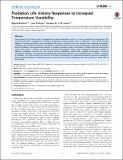Files in this item
Predation life history responses to increased temperature variability
Item metadata
| dc.contributor.author | Barbosa, Miguel | |
| dc.contributor.author | Pestana, Joao | |
| dc.contributor.author | Soares, Amadeu M. V. M. | |
| dc.date.accessioned | 2014-11-20T17:01:09Z | |
| dc.date.available | 2014-11-20T17:01:09Z | |
| dc.date.issued | 2014-09-24 | |
| dc.identifier | 157931238 | |
| dc.identifier | c55cabc6-4ee6-49f3-98cc-1109d1f6d7c5 | |
| dc.identifier | 000342492700065 | |
| dc.identifier | 84907588611 | |
| dc.identifier | 000342492700065 | |
| dc.identifier.citation | Barbosa , M , Pestana , J & Soares , A M V M 2014 , ' Predation life history responses to increased temperature variability ' , PLoS ONE , vol. 9 , no. 9 , e107971 . https://doi.org/10.1371/journal.pone.0107971 | en |
| dc.identifier.issn | 1932-6203 | |
| dc.identifier.other | ORCID: /0000-0003-0327-9580/work/60630771 | |
| dc.identifier.uri | https://hdl.handle.net/10023/5822 | |
| dc.description | This study was funded by a Postdoctoral fellowship to MB (SFRH/BPD/82259/2011) Fundacao para a Ciencia e Tecnologia (www.fct.pt/index.phtml.pt) and with a ‘‘Bolsista CAPES/BRASIL’’, (Project A058/2013) to AMVMS. | en |
| dc.description.abstract | The evolution of life history traits is regulated by energy expenditure, which is, in turn, governed by temperature. The forecasted increase in temperature variability is expected to impose greater stress to organisms, in turn influencing the balance of energy expenditure and consequently life history responses. Here we examine how increased temperature variability affects life history responses to predation. Individuals reared under constant temperatures responded to different levels of predation risk as appropriate: namely, by producing greater number of neonates of smaller sizes and reducing the time to first brood. In contrast, we detected no response to predation regime when temperature was more variable. In addition, population growth rate was slowest among individuals reared under variable temperatures. Increased temperature variability also affected the development of inducible defenses. The combined effects of failing to respond to predation risk, slower growth rate and the miss-match development of morphological defenses supports suggestions that increased variability in temperature poses a greater risk for species adaptation than that posed by a mean shift in temperature. | |
| dc.format.extent | 8 | |
| dc.format.extent | 481890 | |
| dc.language.iso | eng | |
| dc.relation.ispartof | PLoS ONE | en |
| dc.subject | Daphnia-magna | en |
| dc.subject | Population-dynamics | en |
| dc.subject | Inducible defenses | en |
| dc.subject | Climate-change | en |
| dc.subject | Evolution | en |
| dc.subject | Traits | en |
| dc.subject | Risk | en |
| dc.subject | Fish | en |
| dc.subject | Food | en |
| dc.subject | Metabolism | en |
| dc.subject | QH301 Biology | en |
| dc.subject | SDG 13 - Climate Action | en |
| dc.subject.lcc | QH301 | en |
| dc.title | Predation life history responses to increased temperature variability | en |
| dc.type | Journal article | en |
| dc.contributor.institution | University of St Andrews. School of Biology | en |
| dc.identifier.doi | https://doi.org/10.1371/journal.pone.0107971 | |
| dc.description.status | Peer reviewed | en |
This item appears in the following Collection(s)
Items in the St Andrews Research Repository are protected by copyright, with all rights reserved, unless otherwise indicated.

